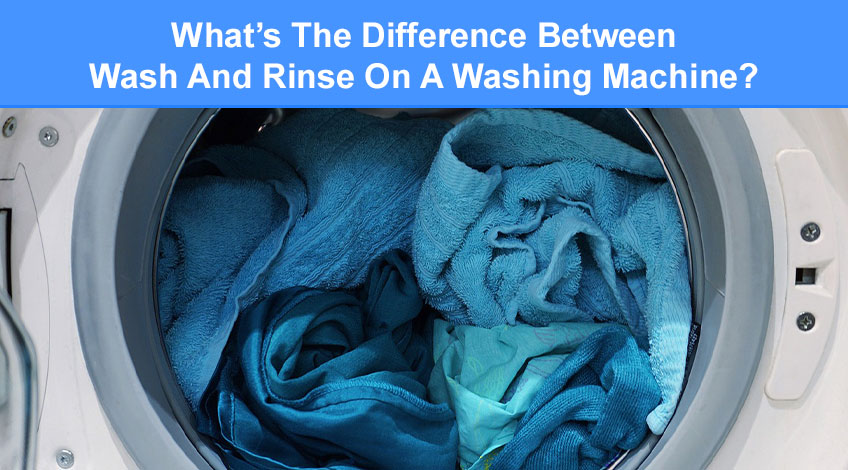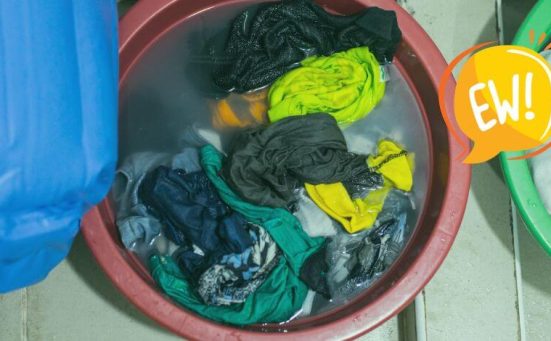
What’s The Difference Between Wash And Rinse On A Washing Machine?
Do you know the difference between a wash cycle and a rinse cycle on your washing machine? And more importantly, do you know which cycle you should be using for your laundry?
When it comes to home laundry most of us simply place all of our washing in the washing machine, add detergent, select the wash cycle and hit the start button. What happens after that is a mystery to the majority of us.
In this article we look at the wash and rinse cycle and explain exactly how they work so that you can understand which cycle is the correct one to use for your laundry. On the face of it, the wash cycle and rinse cycle are very similar; they both fill the drum with water and agitate the drum.
Keep reading to find out more…
What Is The Wash Cycle On A Washing Machine?
When the wash cycle starts in a washing machine, the appliance fills with clean water, the amount of water is dependent on the load size selected. It then adds detergent as the drum turns to agitate the laundry.
This agitation makes the clothes rub against each other and it’s this friction that helps to clean the clothes. As the clothes get spun around in the drum they get covered in soapy water. Some of that soapy water will be absorbed by the clothes.
The bashing together of the clothes allows some of that soapy water to be expelled from the fabric which then leaves dirty, soapy water in the drum.
That water is drained from the machine once the wash cycle is finished.
Fresh, clean water is added to the drum which is the start of the next part of the process.
What Is The Rinse Cycle On A Washing Machine?

The same process used in the wash cycle starts again with the omission of the detergent stage. The fresh, clean water infiltrates the clothes forcing the dirty soapy residue out under agitation caused by the rotation of the drum.
In most cases, the rinse cycle is usually enough to remove all of the remaining dirty, soapy water from the laundry.
The rinse cycle removes any dirt and soap left in the laundry from the wash cycle. This is an important step because detergent can trap dirt and cause colours to run.
It also removes any fabric softener that’s left in the clothes. Fabric softener can cause a waxy layer to build up on the clothes which makes it difficult for the fabric to absorb water. Which makes washing dirt out of the clothes a bit of a challenge.
If you were to stop the machine before the rinse cycle, the clothes would most likely be clean. However, they would also be likely to be coated in a dirty, soapy residue.
Those residues can be problematic especially if you, or a member of your family, has sensitive skin. As soap residue is notorious for exacerbating any pre-existing skin complaints.
Added to which exposure to excessive build ups of detergent can cause damage to certain fabrics.
How Many Rinse Cycles Do You Need?
As the rinse cycle is part of a standard wash program, you usually only need the one rinse cycle. It should be enough to remove any remaining dirt or detergent from the majority of materials.
With that said, there can be times when an extra rinse might be needed. These include;
- Extra Large Loads
If you have filled the drum with laundry, it might need an extra rinse to remove any remaining soup scum, dirt or detergent. - Overdose Of Detergent
If you used too much detergent, you might need an extra rinse to get rid of any excess detergent or white soap marks from your laundry. - Particularly Foamy Detergent
If the detergent you have used is particularly foamy, you might need an extra rinse to remove the excess soapy residue. If not, it could make the clothes too stiff to wear. - Skin Complaints
If you or a family member has sensitive skin an extra rinse will help to remove any soap or potential irritants.
If you know that your clothes will need an extra rinse, it is possible to select an extra rinse on many machines. Although most of the time the regular rinse is all that is needed.
Is A Rinse Cycle The Same As A Wash Cycle?
Some people think that a rinse cycle is the same as a wash cycle, but that’s not true. Both cycles have two different purposes and shouldn’t be confused.
The wash cycle is used to clean the clothes by covering them in water and detergent and agitating them in the drum of the washing machine.
Whereas the rinse cycle removes all of the detergent, dirt and suds left behind after the wash cycle has finished.
What Is Rinse And Spin On A Washing Machine?
Now we have determined the difference between the wash cycle and the rinse cycle, let’s look at the rinse and spin setting. The way washing machines operate is in three stages;
- Wash
The wash cycle uses water, detergent and agitation to get the laundry clean. - Rinse
Next comes the rinse which uses water and agitation to remove the dirt and any residue detergent from the laundry. - Spin
After which the drum spins at high speed using centrifugal force to remove excess water which makes the laundry easier to dry.
Most washing machines have different variations on wash cycles but the rinse and spin setting misses the wash step out completely. Which means using the rinse and spin needs no detergent at all.
Other Common Washing Machine Cycles
Below we’ve listed all of the most common cycles found on most washing machines. They all have their own unique times, speeds and temperatures but here’s a quick explanation of each one.
- Pre Soak
This cycle fills with water and allows the laundry to just sit in that water to soak with no agitation. - Permanent Press/Casual
This cycle typically uses warm water and a lower spin speed than many other cycles. - Cotton, Normal, Linen
These 3 cycles all have relatively high spin speeds but also relatively short time durations. - Delicates, Wool, Hand Wash
These cycles typically use cold water for washing and rinsing and use a slow spin speed as well. - Quick Wash
This cycle uses hot water and is a fast cycle. - Colour
Colour cycles use cold water during the wash and rinse to prevent colours from running. - Heavy, Bulky
These cycles typically have slower spin speeds. - Sanitise
This cycle uses extremely hot water to ensure the removal of germs and bacteria.
There are often other cycles like;
- Whites
- Jeans
- Synthetics
- Baby Care
Which are all pretty self explanatory and will all have their own duration, spin speed and temperature.
If you’re not sure which cycle to choose, you should always consult your handbook. If your machine wasn’t supplied with a handbook or you’ve lost it, you can search online using your machine’s make and model number.
What is the laundry capital of America?
Washington DC! 😂
SEE ALSO: What Is The Fast+ Function On BEKO Washing Machines
Frequently Asked Questions
The difference between wash and rinse in a washing machine is that the wash cycle is used to clean the clothes by covering them in water and detergent and agitating them in the drum of the washing machine. Whereas the rinse cycle removes all of the detergent, dirt and suds left behind after the wash cycle has finished.
On some washing machines it is possible to run a rinse only cycle. Most models that have rinse only will have; rinse, rinse only and rinse and spin cycles on the control panel.
The rinse cycle is used to remove any residue detergent and dirt from the laundry after the wash cycle has completed.
Rinse and spin doesn’t clean clothes, it simply removes the excess detergent and dirt left behind after the wash cycle has finished. It then spins the clothes to remove excess water from the clothes making them easier to dry.
Also, follow us on Pinterest ...



